Only in the autumn do the flowers of the “autumn crocus” (Colchicum autumnale) open. But these flowers should not be confused with those of the spring crocus – the plants are not related.
~ Caution! It‘s a very strong poisonous plant‼️ ~
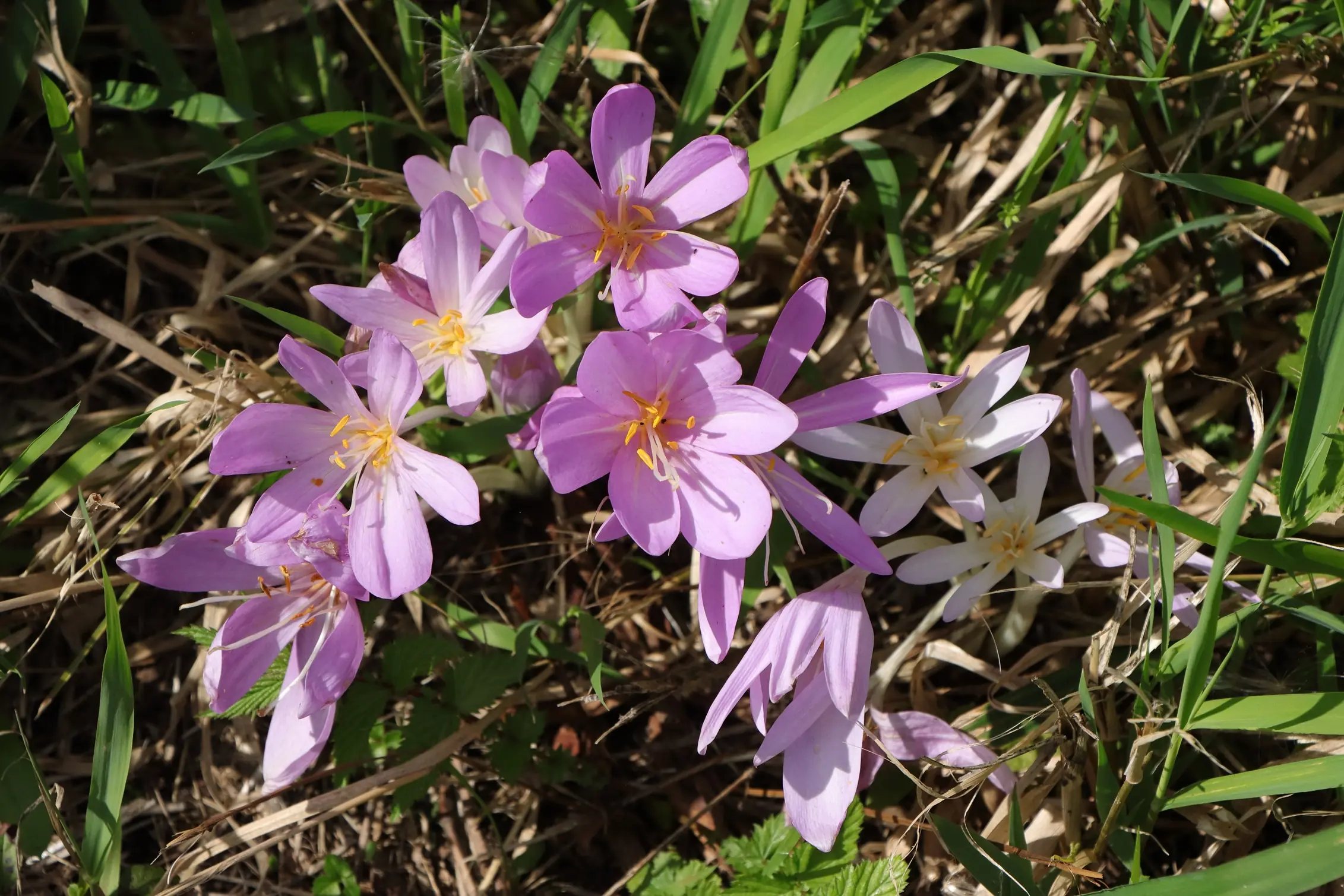

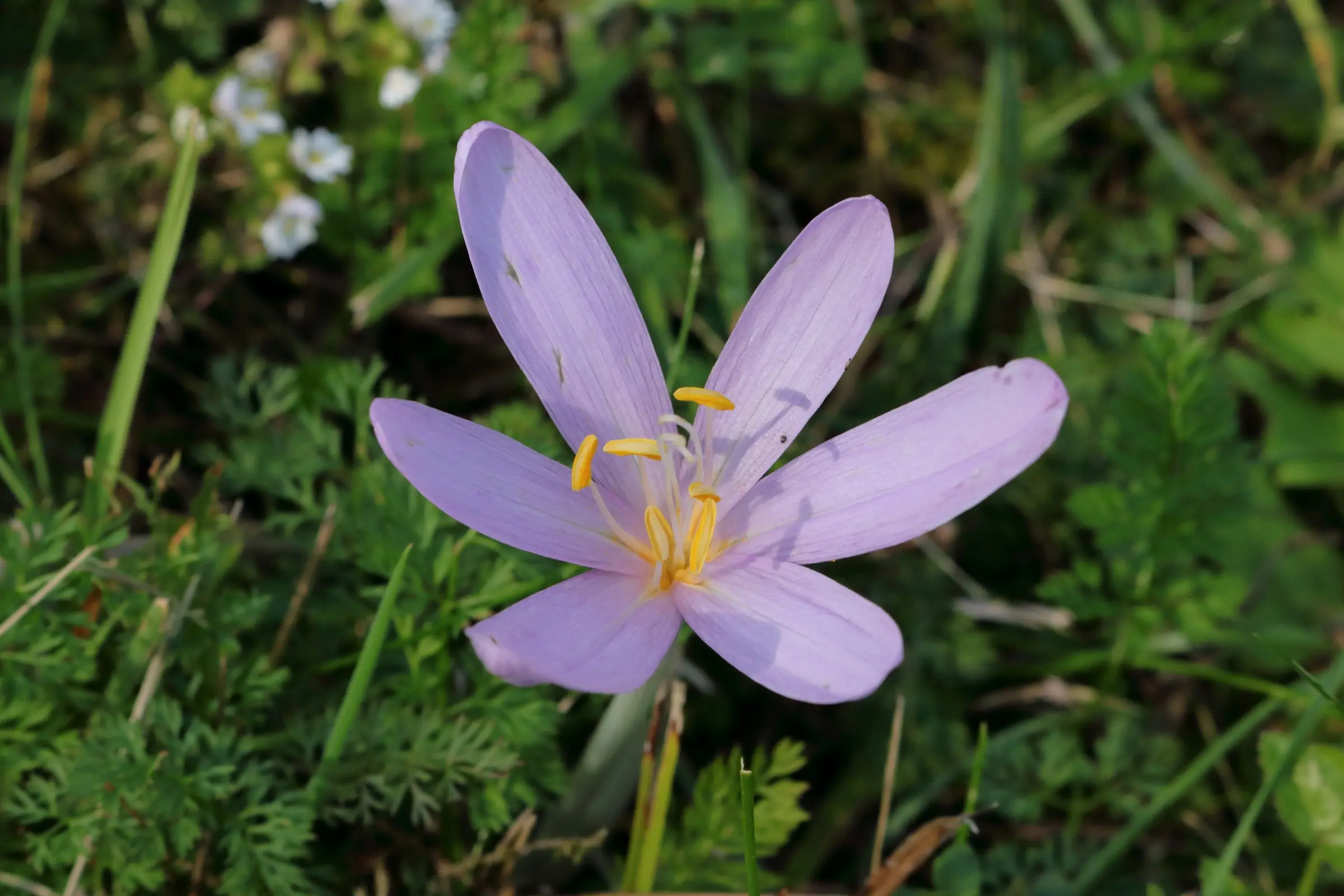


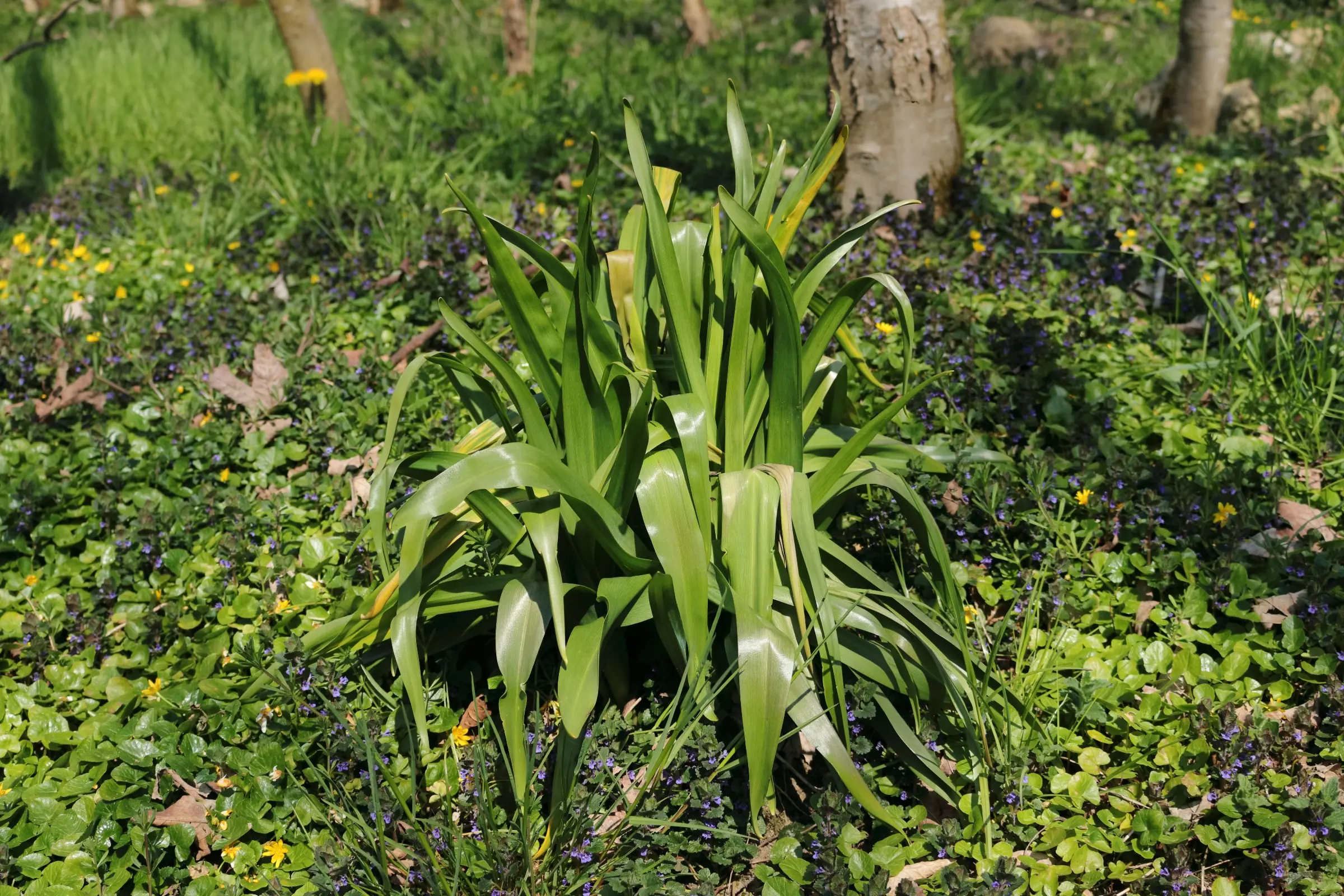
~ Autumn crocus was chosen as the german poisonous plant of the year 2010 ~
Occurrence and distribution: Autumn crocus can be found in broadleaved floodplain forests as well as in tall oatgrass meadows. It prefers damp or wet meadows. It is widespread throughout most of Europe. Autumn crocus prefers a sub-Mediterranean to sub-Atlantic climate and needs a sunny to semi-shady position. The plant needs a chalky, nutritious soil.
Plant description
Growth habit: The plant reaches a growth height between 5 to 35 cm. Leaves are stemless or have only a “short pseudostem”. The lower part of the leaves are yellow to slightly reddish in color. The flowers are located at the end of long stems. Often small groups of several plants are formed.
Leaves: The root forms a thick bulb in which the plant overwinters. A light green rosette of leaves forms in spring and early summer. Individual leaves can be up to 30 cm long. They are broadly lanceolate. On the upper side of the leaves there is a weak central vein. The other veins run parallel on the leaves. The leaves are rigid and grow erect. Later they often bend and turn yellow.
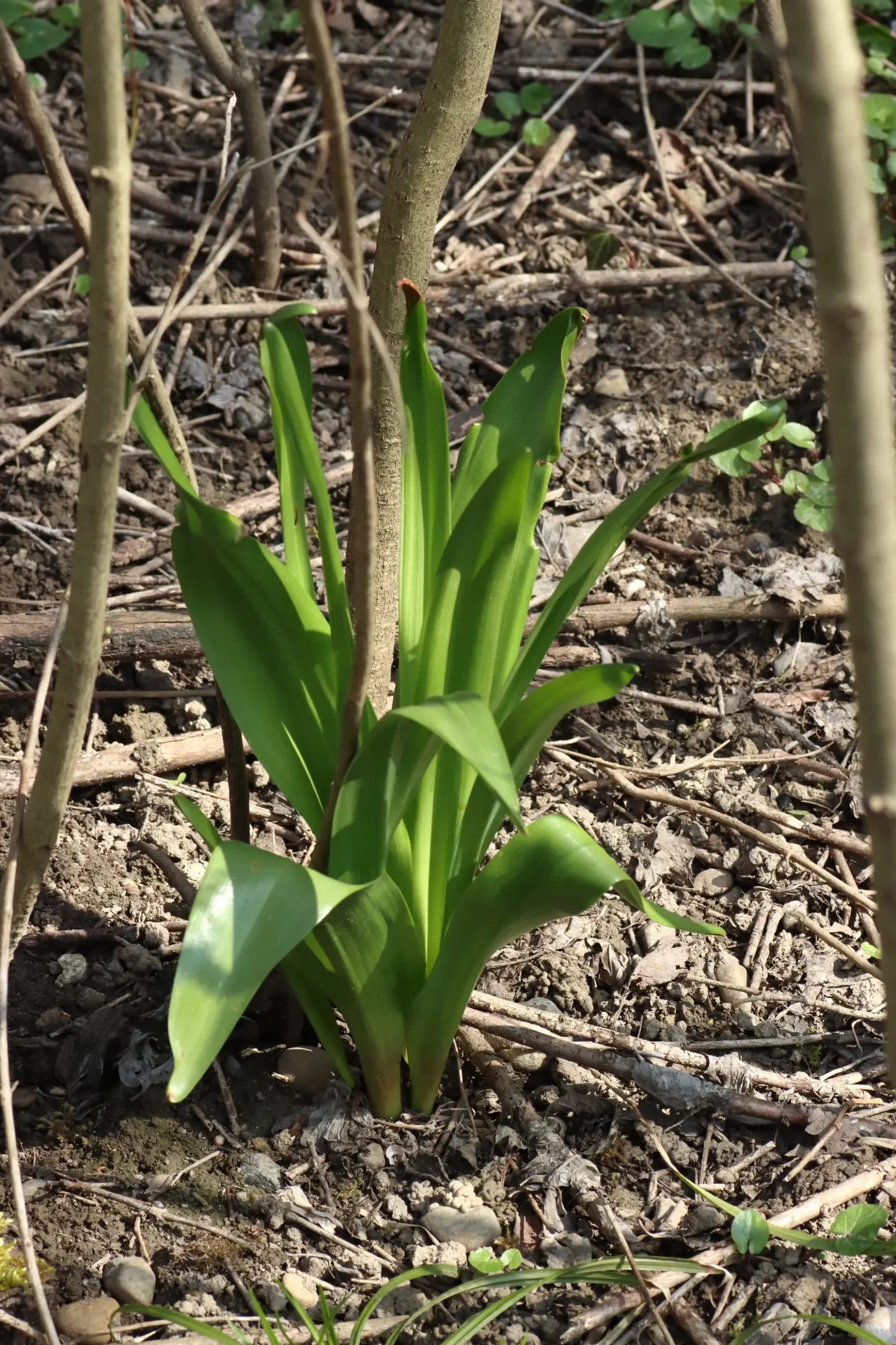

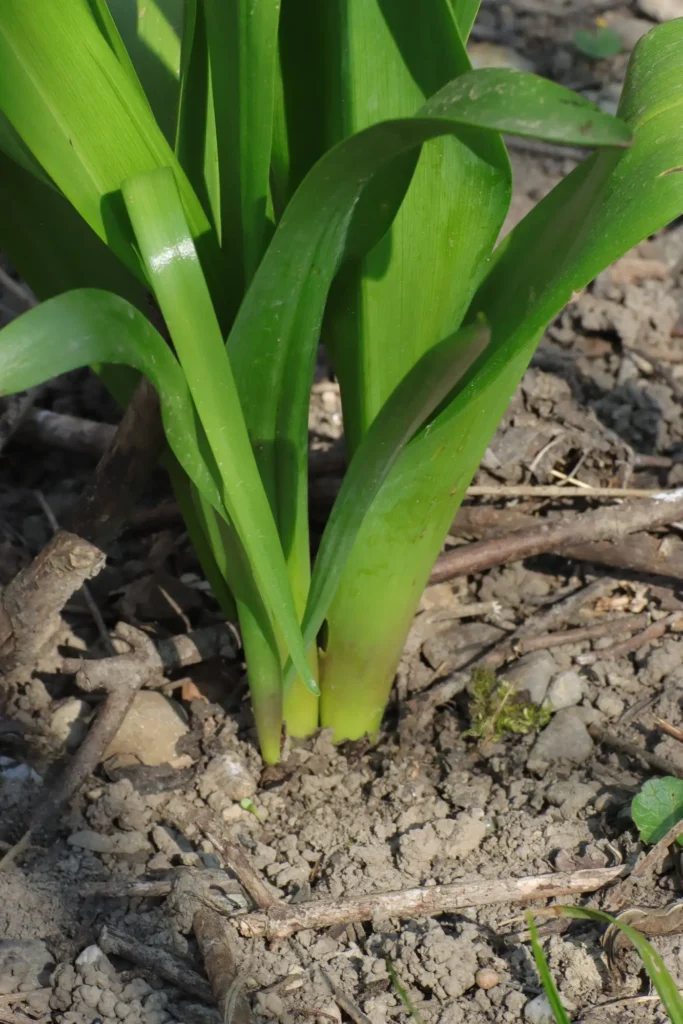
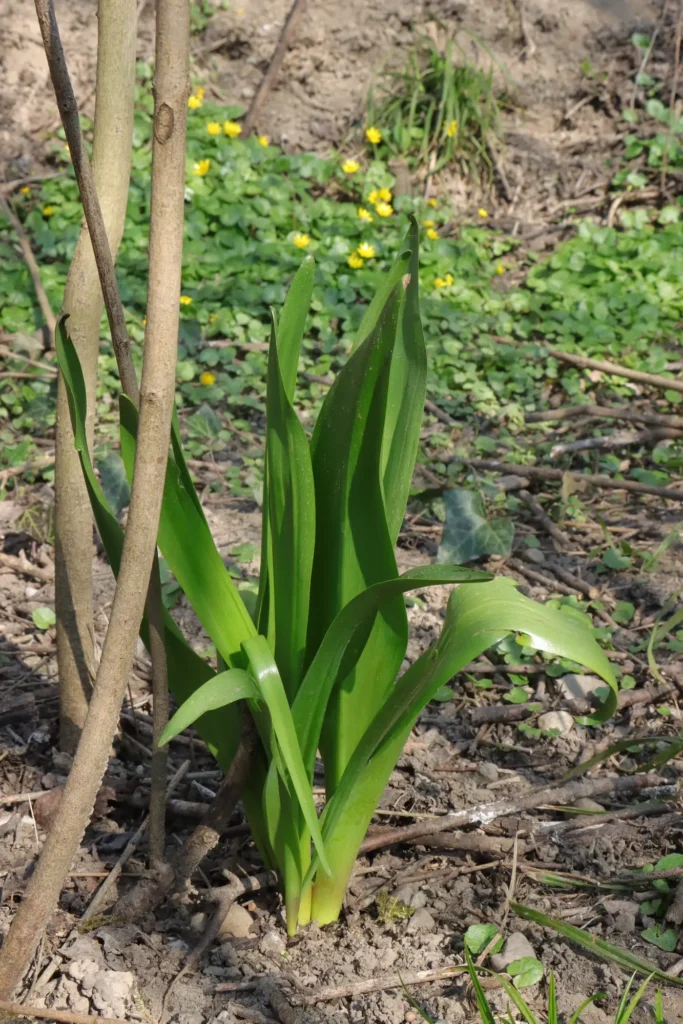
The flowers: Autumn crocus flowers range in size from 5 to 25 cm. They have a distinctive pale pink to purple colour and are often pollinated by bees and bumblebees. The six petals are fused together at the bottom, forming a kind of false stalk. The yellow stamens that form inside are reminiscent of the pollen stamens of the crocus. In the centre of the flower is the stigma, which is also yellow. The flowering period is very unusual for the local flora, as it lasts from August to November.
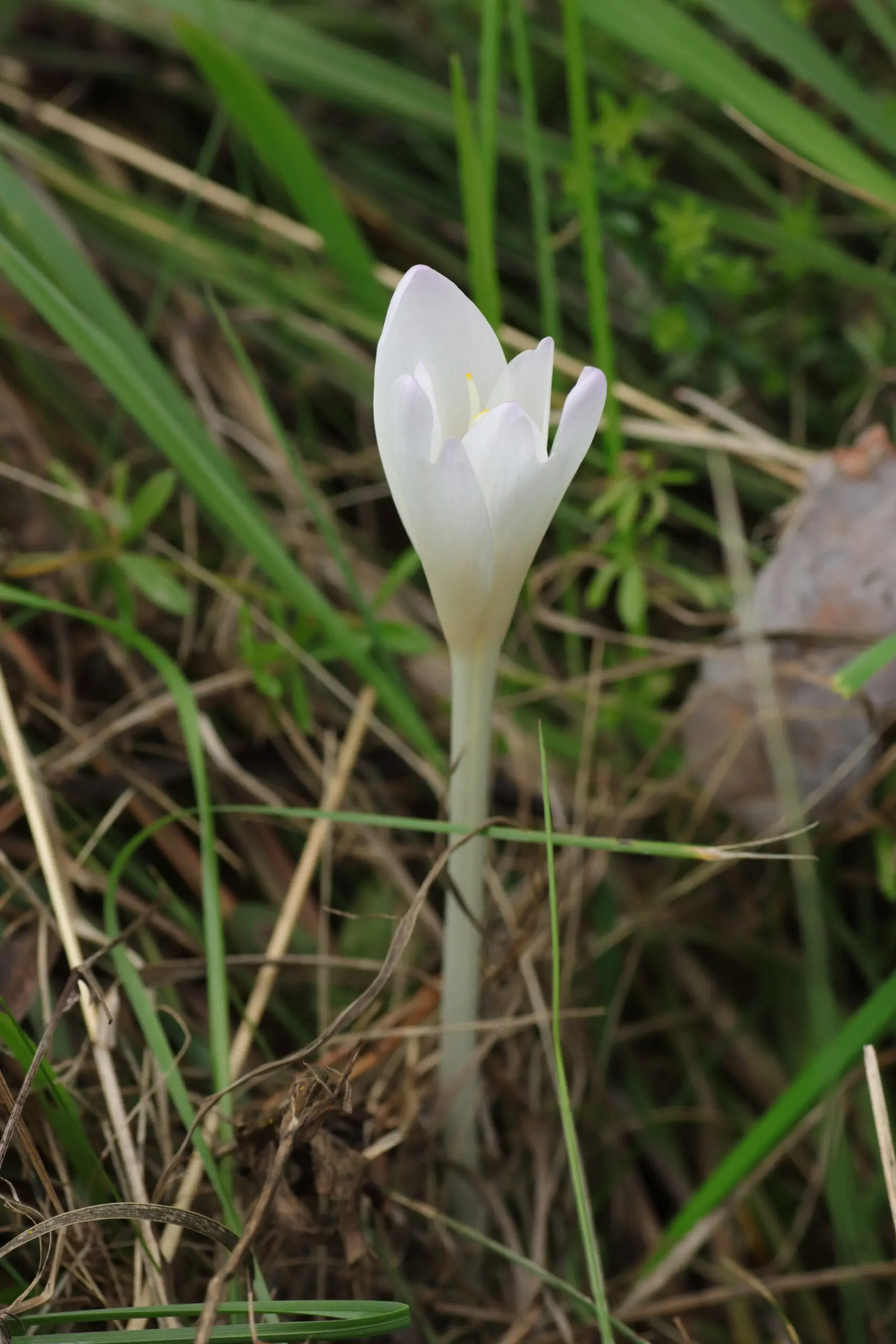

Fruits: A small, initially green – later brown – fruit forms inside the leaf rosette. The brown-black seeds ripen inside the fruit capsule. When ripe, the capsule bursts open, exposing the individual seeds. The main means of dispersal is by ants, as the seeds have a sticky appendage (which the ants seem to love). The photo below shows one of the fruit capsules in an unripe state.
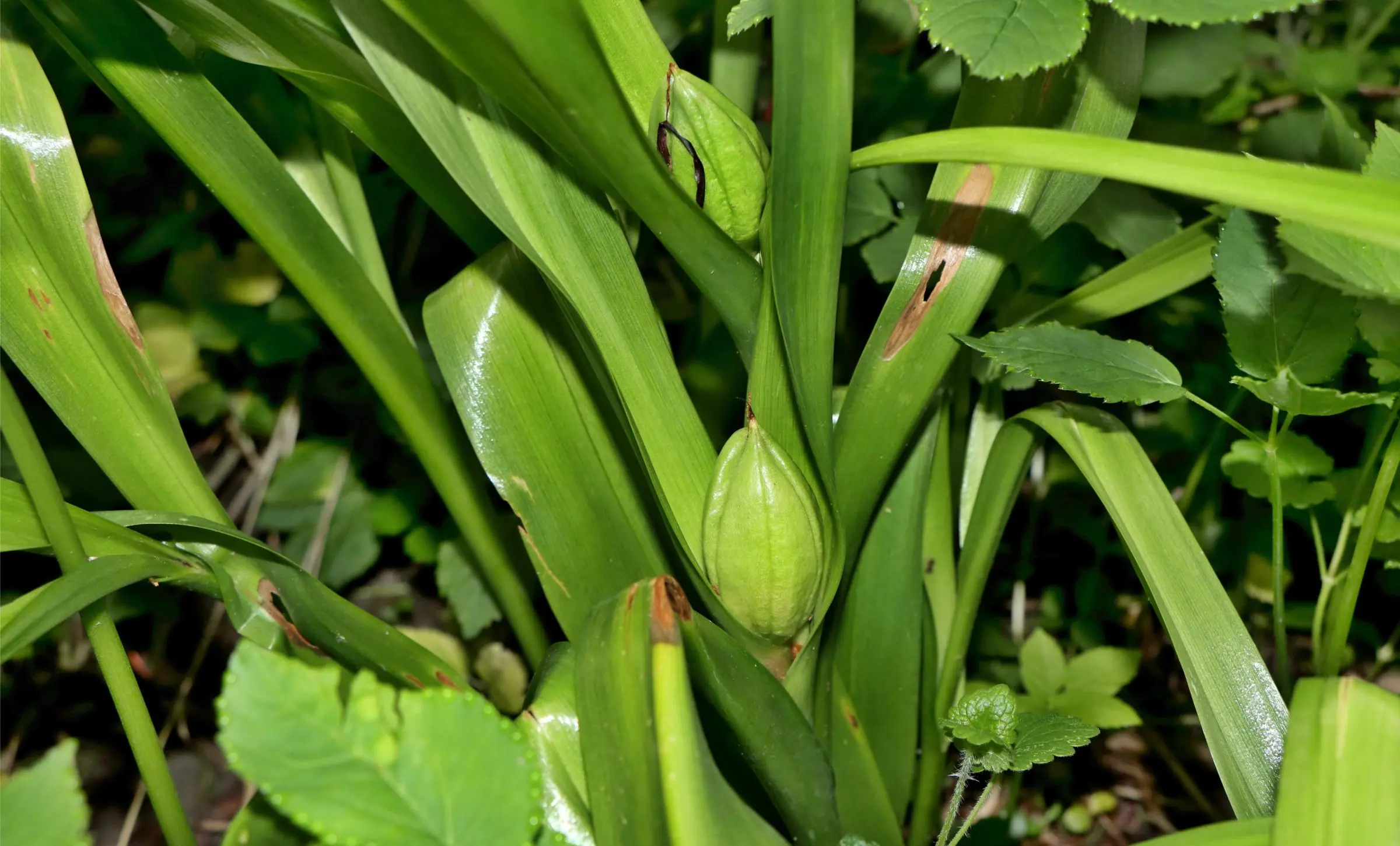
Special features of the plant
Characteristics of the leaves: The leaves have a glossy surface on both sides. They are clearly pointed at the end. This is a clear distinction from the wild garlic -> Here is a PDF with the distinguishing features for download. As always, if “you can’t tell the difference between wild garlic and autumn crocus in the same place, then by all means leave the plants alone”.
Special features of the flowers: Special features of the flowers: At up to 15 cm across, autumn crocus flowers are one the largest in our native flora. The flowers can self-pollinate and are therefore not normally dependent on insects. However, they are visited by wild bees and flies.
Former use as a medicinal plant
Former use as a medicinal plant: Autumn Crocus, which is very toxic, is one of the few remedies that effectively helps acute gout attacks. It has been used in medicine since ancient times to relieve pain during a gout attack. Today it is rarely used in finished preparations and homeopathy. It is strongly discouraged to make your own preparations. Too high a dose can be fatal.
Common / folk names
Common names: The autumn crocus is known by several common names. The include such names as Giftkrokus (poisonous crocus), Giftblume (poisonous flower) or also Teufelswurz (devils root). All these names derive from the poisonous nature of the plant. Some of the more unusual names include „Spinnerin (spinner), Michaelmas flower, Schulblume (school flower), Kälberschisse (calf shit – that’s the literal translation), Wiesensafran (meadow saffron)“. The text of the book Die etymologie der phanerogamennomenclatur states:
– Spinnerin (spinner): The plant begins to flower when the spinning rooms are opened. The assumption that the plant is the “originator of the spinning threads in Indian summer” cannot be proven etymologically.
– Michaelmas flower: Because the plant begins to flower around Michaelmas Day (29 September of a year). This is also where the name Schulblume (school flower) comes from as it was also the end of the german school holidays.
– Kälberschisse / Calf shits: As the plant is dangerous for grazing animals (especially calves).
– Wiesensafran (meadow saffron): The flowers of the plant resemble those of saffron. However, these are two different plant species (saffron is Crocus sativus).
– Teufelswurz (devils root) / Teufelsbrot (devils bread): The name devil’s root / devil’s bread is most likely derived from the poisonousness of the plant, because poisonous plants in particular were associated with the devil.
Name origin
First description of the plant: The plant was first described by the Swedish naturalist Carl von Linné in his 1753 work Species plantarum.
Name origin: The botanical genus name “Colchicum” is probably derived from the landscape “Colchis” (ancient landscape between the Caucasus and the east coast of the Black Sea). This is said to be the original habitat of the plant. Another theory is a reference to the Colchian poisoner Medea (Μήδεια). She is considered a female figure in Greek mythology. In ancient Greek, the plant was known as ἐφήμεϱον (ephēmeron). This derives from the plant’s ability to cause death within a day. The botanical species name “autumnale” can be translated into german as “herbstlich” (english: autumnal). Furthermore, there are various theories for the origin of the German name / trivial name:
Theories on the German origin of the name
Theory 1: It is supposed that the plant was given the name “Herbstzeitlose” (autumn crocus) because of its late flowering time in the year. – Pocket encyclopaedia of the plants of Germany
Theory 2: It is a “constructed” name attributed later. A translation of the work “Species plantarum” (by the Swedish naturalist Carl von Linné in 1753) is considered a possible clue for this. In the following translation, the plant is already called autumn crocus: “Vollständiges Pflanzensystem: nach der dreyzehnten lateinischen Ausgabe und nach Anleitung des holländischen Houttuynischen Werks übersetzt und mit einer ausführlichen Erklärung ausgefertiget, Band 5” from 1784.
However, this can be contradicted with the work “Allgemeine deutsche Bibliothek” by Nicolai, Christoph Freidrich published in 1776. Another even earlier mention from 1767 can be found in “Rudolph Augustin Vogels neue medicinische Bibliothek, Band 7“. Since a plant is already called ” Zeitlose” (timeless) in this. There are also other records with the name “Zeitlose” (see Theory 4).
Theory 3: In old High German, the plant was called “heilhoubit / heilhoubita / heilhoubito“. In this context, Gerhard Köbler’s dictionary refers to the words “houbit” – modern German: “Haupt, Kopf, Spitze” (head, tip) – as well as “heil” – modern German: “heil, ganz, gesund, unversehrt” (whole, healthy, unharmed). This is also reflected in the Old High German dictionary of the Saxon Academy of Sciences in Leipzig. In this, the endings -o and -a are regarded as errors. The plant was already named “hailhobet” in the 12th century or “heilhaubet” (14th / 15th century) or also “heilhaupt” (15th century).
Theory 4: In the work „New Kreüterbuch“ by Leonhart Fuchs from 1543, the plant genus “Colchicum” is already referred to as “Zeitlose” (timeless).
My own interpretation on the German origin of the name
My own interpretation: It is provable from the above theories / sources that the plant was already called ” Zeitlose” (timeless) before it was described by the Swedish natural scientist Carl von Linné. Due to the flowering time in autumn, it is therefore logical that a summary was made to the word ” Herbstzeitlose” (autumn crocus). I will probably not be able to find an exact proof of this.
An exact explanation of the origin of the German name can no longer be determined. Even in the encyclopaedias / dictionaries of Grimm and Meyer, no derivation is given. Should you, dear reader, have further proof of the origin of the name, you are welcome to send it to me at pflanzenbestimmung@blumen-natur.de.
Endangerment of the plant
Endangerment of the plant: The autumn crocus is not classified as endangered on the German Red List. Nevertheless, it is increasingly being displaced from fields and meadows by intensive agricultural use.
Distribution-codes: A, AV, M1, M2, F, K
The following section is not suitable for sensitive people. Please read it only if you are really interested. It contains a lot of medical terminology and a description of symptoms.
Toxicity of the plant
Toxicity of the plant: All parts of the plant are very toxic. It should not be harvested or eaten. It can be fatal to both animals and humans. The leaves and seeds contain the highest levels of the poison colchicine. Many cases of poisoning have been reported. Some have been fatal. Children are particularly susceptible to poisoning. Poisoning is also possible through the milk of goats, sheep and cows, as they can eat part of the plant. If the plant is dried, stored or cooked, it remains poisonous.
Effect of the toxins
Effect of the toxins: Because colchicine is a mitotic cell poison, the toxins in autumn crocus have a damaging effect on the cell nucleus. In this case, cell division is inhibited. In humans, the clinical symptoms can be divided into three phases.
Phase 1: The first symptoms of poisoning appear 2 to 6 hours (rarely up to 18 hours) after ingestion. Initially, symptoms include a burning sensation in the mouth and difficulty swallowing. The transformation of the toxins in the stomach and intestines causes severe irritation of the mucous membranes. This leads to stomatitis, pharyngitis and gastroenteritis. Later, other symptoms such as nausea, vomiting, diarrhoea and intestinal cramps may occur. This is a reaction to absorption into the enterohepatic circulation.
Phase 2: After 24 to 72 hours, multi-organ failure occurs. This can manifest itself in the form of cardiovascular shock (pumping failure of the heart / blood is no longer transported through the body), respiratory failure (respiratory paralysis / respiratory arrest), renal failure (the kidney stops functioning), Rhabdomyolysis (breakdown of muscle cells / muscle fibres), the occurrence of electrolyte disorders (such as hyponatremia – low sodium level in the blood, hypophosphatemia – low phosphate level in the serum, hypocalcemia – low calcium level in the serum, hypomagnesemia – low magnesium level in the blood).
There is also hyperglycaemia (increased blood sugar level – as insulin is no longer released into the blood), metabolic acidosis (over-acidification of the blood due to the lack of anions / reduction of bicarbonate in the blood (HCO3-), bone marrow depression with leukopenia / thrombocytopenia. Due to the effect on the central nervous system, behavioural changes in the form of delirium, convulsions and even coma are also possible.
Phase 3: 7-10 days after ingestion (assuming you’ve survived the previous stage), the body will recover. During this phase, leukocytosis and hair loss often recur. As a late consequence, neuromuscular disorders (long-lasting complaints/illnesses of the muscles, nerve fibres and neurons) often occur.
Description of the symptoms
Description of the symptoms: Within the cells, the tubulin dimers are degraded and therefore cause an inhibition of cell division. This mainly affects cells with a high division and metabolisation rate, such as the bone marrow. Initially, an increase in white blood cells (leukocytosis) is detectable. However, as the bone marrow is attacked, a bone marrow depression occurs. This leads to a reduction in platelets (thrombocytopenia) and a reduction in leukocytes (white blood cells) in the form of leukocytopenia. This leads to severe bleeding! In addition, the tiny blood vessels (so-called capillaries) are attacked and destroyed. Pulmonary oedema can also occur, as this tissue also contains capillaries! TL;DR: Important components of the bloodstream are attacked by the toxins contained.
The destruction of thrombocytes (thrombocytopenia) leads to an excessive formation of thrombin and fibrin. These lead to so-called “disseminated intravascular coagulation (DIC)” by clumping together in the blood vessels. Since this occurs very quickly (within a few hours / days), bleeding occurs.
The effects on cells lead to ‘rhabdomyolysis’ (breakdown of muscle cells/fibres). This can lead to kidney failure if left untreated.
Paralysis of the central nervous system is possible if the “blood-brain barrier” is overcome and the toxins can spread to the brain. Initially there is an energetic state, but later there is paralysis of the vital functions carried out by the central nervous system. The resulting symptoms are Difficulty concentrating, disorientation (in the form of delirium), muscle spasms (convulsions), bleeding in the brain, coma, shortness of breath (dyspnoea) / respiratory depression. As nerve damage is also caused when toxins enter the brain, neuritis (inflammation of the nerves) may occur.
Target organs / LD50
Target organs of toxins: The target organs of toxins are mainly the mucous membrane of the gastrointestinal tract, cells, bone marrow, blood vessels, kidneys and liver as well as the peripheral and central nervous system.
- Presumed lethal dose in humans (LD50): The seeds are among the most toxic parts of the plant. The LD50 dose is 1.5 to 2.0 grams in children and 5.0 grams in adults. (Source: University Frankfurt)
- Lethal dose in cattle / horses: The lethal dose in cattle is 1.2 to 1.5 kg of the fresh leaves. In horses, the lethal dose is 1.2 to 3 kg of the fresh leaves – or 5 kg of the dried leaves after three days (Source: CliniTox database).
In case of poisoning, the affected person must be taken to hospital immediately! If necessary, a doctor should also consult a poison control centre.
Treatment of intoxication
Treatment of intoxication: Treatment of intoxication must always be carried out by hospital specialists. The primary aim is to remove the poison and intensive medical monitoring is carried out. This consists of water and electrolyte balancing as well as treatment of the symptoms. Self-treatment is not possible as there is no known antidote.
Substances contained in the plant
Substances contained in the plant: The alkaloid “colchicine” is contained in the entire plant. The name of the poison is derived from the Latin name of the plant. It also contains other tropolone alkaloids such as demecolcin, inulin, aspargine, colchicoside.
Colchicine content in the plant parts: The content of alkaloids varies greatly. Mature seeds: 0.5% – 1.2%, fresh flowers 1.2% – 2.0%, fresh leaves 0.15% – 0.4%, tubers 0.1% – 0.6% (Source: CliniTox database).
First aid: Treatment in a hospital is mandatory. Do not attempt to treat the patient yourself!
Great piece of writing! Keep posting such kind of information on your blog.
I’m really impressed with it. You have done an excellent job.
I certainly dig it and in my opinion recommend it to my friends.
I’m sure they will benefit from this website.